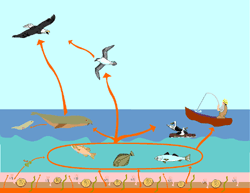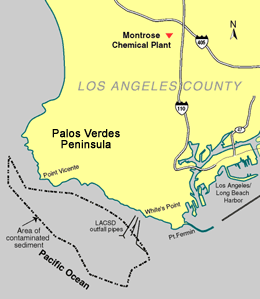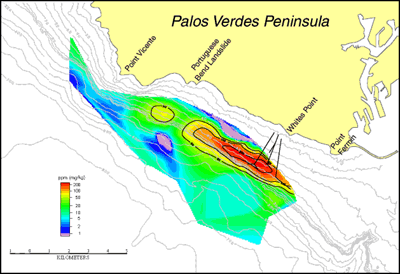Contact Superfund, Pacific Southwest
Pacific Southwest, Region 9
Serving: Arizona, California, Hawaii, Nevada, Pacific Islands, Tribal Nations
Palos Verdes Shelf
Reports
- Proposed Plan June 2009 (PDF) (12pp, 697K)
- Final Feasibility Study (PDF) (239pp, 10MB)
- Remediation Investigation Report (final) (PDF) (472pp, 10.8MB)
- Bioturbation Report (final) (PDF) (105pp, 8MB)
- Geotechnical Measurement Report (final) (PDF) (145pp, 13MB)
- Sediment Displacement Study (final) (PDF) (137pp, 9.8MB)
- Field Pilot Study of In Situ Capping of Palos Verdes Shelf Contaminated Sediments (PDF) (248 pp, 3.6MB)
On December 19, 2000, the U.S. Department of Justice (representing the EPA and several natural resource trustee agencies) and the California Attorney General announced a $73 million settlement with Montrose Chemical Corporation of California, Aventis CropScience USA Inc., Chris-Craft Industries Inc., and Atkemix Thirty-Seven Inc., companies that either owned or operated DDT-manufacturing plants in Los Angeles County.
Along with the prior settlements in this case, a total of approximately $140 million was collected to be used by federal and state agencies to help rehabilitate natural resources and clean up DDT contamination on the offshore Palos Verdes Shelf.
Department of Justice News Release ![]()
September 30, 2009 EPA Signs Interim Record of Decision (PDF) (130 pp, 6.45 MB)
EPA signs interim Record of Decision (ROD) that selects a cleanup remedy for Palos Verdes Shelf. The selected remedy has three components: placing a cover of clean silty sand over the portion of the contaminated sediment deposit that has the highest contaminant surface concentrations and appears to be erosive; monitoring the natural recovery that is occuring in other areas of the Shelf; and continuing the Institutional Controls program that uses outreach and education, enforcement and monitoring to minimize consumption of fish that contain DDTs and PCBs.
June 2009 EPA Announces Proposed Plan (PDF) (12 pp, 685 KB)
The proposed plan presented EPA's preferred alternative on how to address the risks to human health and the environment posed by contaminated sediment at the Palos Verdes Shelf Superfund site. The proposed plan presented other alternatives that EPA considered and announced a series of public meetings and open houses where members of the public could learn more about the preferred alternative and comment on the proposed plan.
May 2009 Palos Verdes Shelf Feasibility Study (PDF) (239 pp, 37.4 MB)
The Feasibility Study describes the development, evaluation, and comparision of remedial action alternatives to manage the contamianted sediment at Palos Verdes Shelf. Its appendices include detailed analyses of the technologies considered in devleopment of the alternatives, i.e., dredging, capping, and natural recovery, as well as the institutional controls program currently in place to control risk.
February 2008 Update–
Remedial Investigation Report Completed; Feasibility Study Underway - Fact Sheet (PDF) (8 pp, 3.8 MB)
This Fact Sheet summarizes the Remedial Investigation Report. The report describes the Palos Verdes Shelf Study Area. It presents information on the nature and extent of DDT and PCBs contamination, discusses the long-term fate and transport of the contaminants, and assesses the risks to human health and the environment posed by the site. The report provides the information and analysis needed to develop the feasibility study.
August 6, 2007 Update
- EPA and MSRP released Marine Fish Contaminants Study for the Southern California Coast - Fact Sheet (PDF) (4 pp, 570K, About PDF)
- Southern California Coastal Marine Fish Contaminant Survey Report (PDF) (107 pp, 4.2M)
- News Release (8/6/07)
May 2005 Update (PDF) (6 pp, 408K): Updates on EPA's activities on the Palos Verdes Shelf Institutional Controls Program and Remedial Investigation/Feasibility Study.
Summer 2004 Update: EPA initiates marketplace fish monitoring program to assess whether contaminated white croakers are reaching consumers.
EPA conducts additional field studies on Palos Verdes Shelf and collects ocean fish for sampling.
Background
From 1947 to 1983, Montrose Chemical Corporation manufactured DDT at its plant near Torrance, California. The plant discharged wastewater containing the now-banned pesticide into Los Angeles sewers that emptied into the Pacific Ocean off White Point on the Palos Verdes Shelf (PVS). The DDT manufacturing process also resulted in groundwater and surface soil contamination on and near the Montrose plant property.
It is estimated that over 800 to 1000 tons of DDT were discharged between the late 1950s and the early 1970s. Several other industries also discharged PCBs into the Los Angeles sewer system that ended up on the PVS by way of outfall pipes. The PVS site is defined by the large area of DDT- and PCB-contaminated sediment on the ocean floor in the vicinity of the Palos Verdes peninsula, near Los Angeles, California.
In its 1994 report, the U.S. Geological Survey (USGS) characterized an area of 44 km2 (17 sq. miles) on the PVS with elevated levels of DDT and PCBs in surface sediments. Subsequent data showed that DDT- and PCB- contaminated sediments covered a larger area, EPA expanded the PVS study area to include the area from Point Fermin in the southeast to the southern edge of the Redondo canyon, northwest of the Palos Verdes peninsula, to a depth of 200 meters down the PVS slope.
Ecological and Health Risks

Illustration of how DDT may move from ocean floor sediment up through the food web (click image for larger version)
High levels of DDT and PCBs in sediment and water threaten the Palos Verdes Shelf marine environment. DDT and PCBs enter the food chain through worms and other invertebrates and microorganisms, which are consumed by other marine life. DDT and PCBs accumulate in fish tissue, that can harm fish-eating birds, marine mammals, and birds of prey that feed on both.
For people, eating DDT- and PCB-contaminated fish can increase cancer risks, harm the liver, and affect the central nervous system. Nursing infants whose mothers regularly consume the fish are also at high risk.
Historically, the waters of the Palos Verdes Shelf have been used extensively by both sport and commercial fishers. Sport anglers fish from boats and beaches in the area. The waters are also used for swimming, windsurfing, surfing, scuba diving, snorkeling and shellfishing.
Since 1985, fish consumption advisories and health warnings have been posted in southern California because of elevated DDT and PCB levels. Bottom-feeding fish are particularly at risk for high contamination levels. In June 2009, the state Office of Environmental Health Hazard Assessment ![]() , issued a new health advisory and safe eating guidelines for fish from coastal areas of Southern California, including the PVS. The advisory warns anglers against eating certain species of fish from specific locations between Ventura Harbor to San Mateo Point. The guidance advises against consumption of white croaker (also known as kingfish or tomcod),
barred sand bass, and topsmelt caught from the coastal area between Santa Monica Pier and Seal Beach Pier, an area that includes PVS
. Consumption of other
fish from this area, including kelp bass,
sardines and sculpin, should be limited.
, issued a new health advisory and safe eating guidelines for fish from coastal areas of Southern California, including the PVS. The advisory warns anglers against eating certain species of fish from specific locations between Ventura Harbor to San Mateo Point. The guidance advises against consumption of white croaker (also known as kingfish or tomcod),
barred sand bass, and topsmelt caught from the coastal area between Santa Monica Pier and Seal Beach Pier, an area that includes PVS
. Consumption of other
fish from this area, including kelp bass,
sardines and sculpin, should be limited.
Cleanup Approaches
In 1996, EPA initiated a Superfund non-time critical removal action to evaluate the need and feasibility for actions to address human health and ecological risks. The non-time critical removal action later resulted in the PVS Institutional Controls Program. See the timeline page to track removal actions and associated activites.
In August 2000, EPA initiated a pilot capping project in which they placed clean sediment over a small area (1%) of the contaminated ocean floor. This pilot project provided an opportunity to evaluate cap placement methods and construction related impacts. In 2002, EPA concluded that cap construction would be technically feasible. The pilot project was followed by several data gap studies to better understand the site and the fate and transport of DDT and PCBs mixed in the PVS sediment.
The Remedial Investigation Report confirmed that the contaminated sediment deposit is thin-2 inches to 2 feet thick-and covers several square miles. The most contaminated sediment is buried under a layer of cleaner sediment whose surface concentrations of DDT and PCB have dropped over time.
The Feasibility Study evaluated the three principal remedies used at sediment sites: dredging, capping, and natural recovery. The PVS site remediation is challenging because the area of concern is a thin layer of solf sediment at a depth of 150 to 300 feet that extends over several square miles. Because the most contamianted sediment is under a foot or less of cleaner sediment, care must be taken to avoid exposing the buried material. EPA will take a phased approach to cleaning up the site. Based on the success of the interim remedy and what we learn from the additional natural recovery studies, EPA will assess whether additional actions are warranted.


